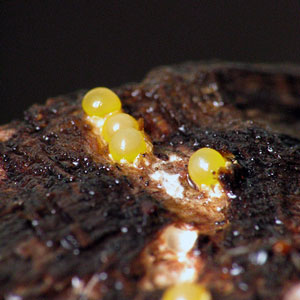What Caused Tiny, Black Specks on Interior Walls?
By Chris Williams on October 17, 2013.

Close up picture of artillery fungus on the ground.
Question
I just discovered lots of small black specks all over my living room walls and drapes near the window. They look like cockroach droppings or fly specks or something similar but they don’t wash off. We have had a few fruit flies in the house. Could they be the cause of the spots?
Answer
No, these don’t sound like insect droppings. I think what you are seeing might be spores that were ejected from the artillery fungus, Sphaerobolus stellatus. This fungus is most often seen outside where the black spores end up on siding, cars, porches, decks and other surfaces. We usually get complaints of artillery fungus in spring and fall because the fruiting bodies are produced when temperatures range from 50-68° F. People often think that the spots are fly specks or insect droppings.
Artillery fungus (or “shot gun fungus”) is a fungus that feeds on rotting organic material, usually wood-based. Around homes, old, rotting shredded wood mulch around the foundation is usually the source of the fungus. Artillery fungus will also grow on dung, or on rotting wood in benches, sheds, etc. or sometimes in potting soil that has a wood component. We occasionally see the evidence of artillery fungus indoors, usually associated with potted plants. Potting soil may be the source of your problem, or maybe you’ve topped off your pots with a layer of mulch.
The fungus produces a barely visible, cup-shaped fruiting body that holds the spores. When water accumulates in the cup, it inverts, forcibly shooting the spores as high as 20 feet. Unfortunately because the fungus is sensitive to light, the dark spores are projected towards light surfaces so they end up most often on light-colored siding, white cars, or on sunny windows.
The brown to black spores are like tiny dots of tar that have been super-glued where they land. Even experts say that removing the spots is “virtually impossible.” Scrubbing and scraping helps somewhat but you may end up doing damage to the surface and making things worse. Even pressure washing doesn’t work unless done right after the spores are ejected. The good news is that the damage from the fungus is all cosmetic.
How to Avoid Artillery Fungus in the Future
Outside your home, scrape away layers of old wood mulch and start over. Use pine bark mulch instead of shredded hardwood mulch. Cedar, redwood, and cypress mulches seem to be resistant to the fungus. Raking wood mulch opens it up to air circulation and helps dry it out. Even better, don’t use wood products at all for mulching. Substitute black plastic, stone, pea gravel, or synthetic mulches. If you use wood mulch, replace it annually or at least add a layer of fresh mulch on top of old mulch early each spring.
For potted plants, repot any suspect plants with new potting soil (make sure it doesn’t contain wood parts) and don’t top-dress the pot with wood mulch.
Photo credit: Michael_Whitehead / Foter / CC BY-NC-SA